Exploring alchemical stages in the creative process.
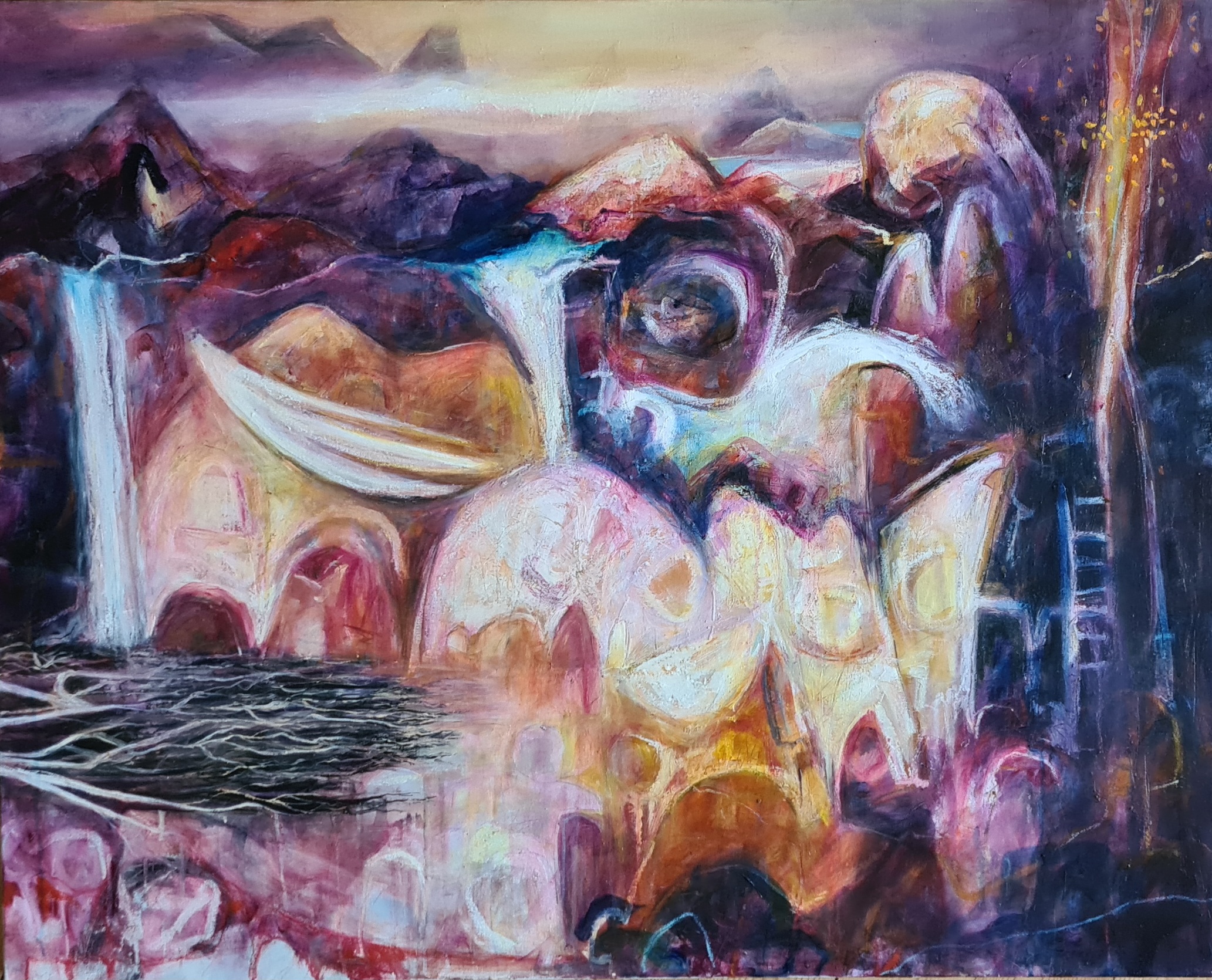
My first real encounter with Alchemy was last October, when I was searching for symbols and metaphors that resonated with me for my own art-making practice. I found it to be hugely complex and put it aside until stumbling upon it once again through my deepening interest in Carl Jung, and the connecting Jungian Arts-Based Research (JABR). Happening upon Dr. Susan Rowland resulted in a brief email conversation and my participation in an online weekend course (The Creative Psyche and Arts-Based Research: A Transdisciplinary Conference, organised by the London Arts-Based Research Centre, at the Association of Jungian Analysts’ Centre in London, in June 2023). This was a profound experience and I felt for the first time in a long while that I was not alone in my understanding and questions of the world I inhabit.
Various speakers shared their insight and wisdom during the weekend, and I came away being both excited and overwhelmed by the possibilities that lay ahead of me. I listened to podcasts, read articles, books, and journals, all of which elicited a deeper understanding of the connection between Jung and arts-based research. My journal helped me to keep everything together and begin to connect the dots. What was recurring over and over was Jung’s fascination with alchemy during the last thirty years of his life, and how much this impacted his work.
Part of one of my two journals which I used to record and make sense of the scholarly texts that I was reading.
I will try to simplify the connection between the two, as I understand it. Jung developed what he termed ‘active imagination’ as a way of connecting with the unconscious. An example of this as personally relevant is the creation of my artwork through a mainly intuitive approach. Jung realised that he shared this with alchemy’s focus on internal conversation and the resulting transformation. I can also apply this to the research process that I go through when writing an academic paper.
Alchemy dates back as far as ancient Egypt, and was adapted by various cultures over time and place until the age of Enlightenment when it was eventually rejected. Alchemists were known to explore the possibilities of turning something basic (such as lead) into something precious (such as gold). Until the age of Enlightenment and the modern scientific paradigm, alchemy represented the natural flow between science and art; an absence of the subject/object split. The severing of science and art has only recently been reconsidered with the much needed recognition of arts-based research rising since the 1990s.
It is possible to simplify the goal of alchemy as ‘transformation’, which Jung also saw as relating to the inner self, a transformation of one’s psyche. Alchemy is the understanding of how the unconscious (the spirit) relates to consciousness (the body), which Jung saw as one’s total personality, the Self (the soul).
It can be understood that Jung was creating a ‘third thing’, blending the ancient knowledge of alchemists with his understanding of active imagination and amplification. The latter references the essential element of understanding through exploring the symbols which have arisen through the process of active imagination. These symbols join us in the universe. This discovery was revolutionary for me; despite my exhibition Inner Landscapes (https://nikkidemarco.com/portfolio/inner-landscapes/) producing a wealth of ‘material’ using active imagination, I had felt that I would need to be a psychoanalyst to begin to make sense of all the symbols within. I saw creatures that were part animal and part human, flying fish, bird’s eyes, many ladders, trees, and an obsession with mountains and rocks, waterfalls, and oceans. My audience saw many other symbols, and I was impassioned to make sense of this overwhelming information.
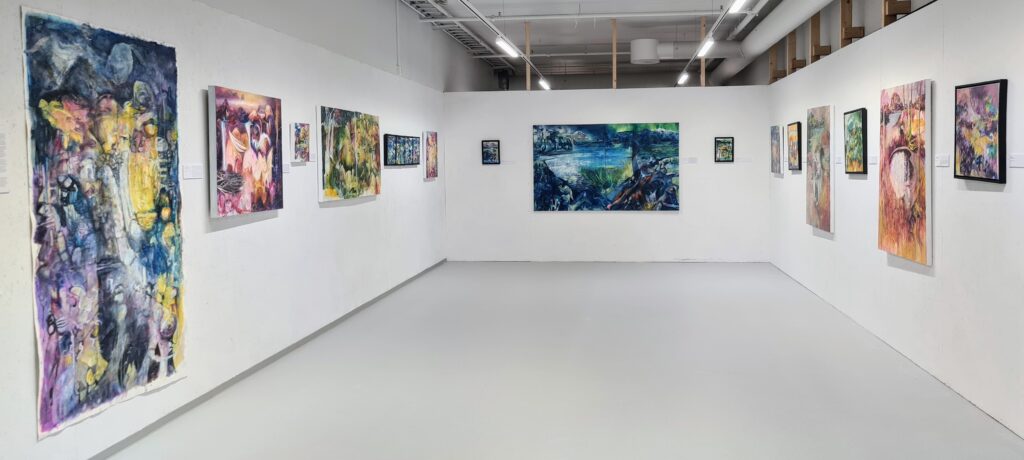
Three of the four walls of my Inner Landscapes exhibition from spring 2023, where I attempted to mine the layers of my unconscious self through the creative act. It was through this that my interest in accessing the psyche through art grew.
I have known about Jung’s term of ‘synchronicity’ for nearly thirty years. It has always made so much sense to me and I try to allow synchronistic events guide me in my life. The events, as stated above, that led me to rediscover Jung and therefore alchemy is without doubt synchronistic. The connecting events are too many for this blog, but do include the happening upon a podcast which took me to aras.org, which is “a pictorial and written archive of mythological, ritualistic, and symbolic images from all over the world and from all epochs of human history” (https://aras.org/about). It houses around 18,000 photographic images with scholarly commentary attached to each. It was at this time that I also begun to understand the crucial stage that followed Jung’s active imagination; amplification. This essential step is where one is able to begin to make sense of the symbols and metaphors that appear through active imagination. Amplification is where one conducts research to access the ‘collective conscious’ from all time and place. Jung believed that besides our conscious and unconscious, we also have a collective conscious, one that connects us all through shared archetypes and symbols.
I now had access to begin to make sense of the paintings that I had created for my exhibition, understanding that it is through this that I could begin to move forward in my life.
Quite simply, it was not enough for me to reveal my inner landscape through painting (active imagination), but I needed to understand it through appropriate research (accessing the collective unconscious).
Knowing that my further studies will undoubtedly involve delving deeper into accessing and understanding the psyche through creative practice, I wanted to unpack and analyse at least one of my artworks. Researching the symbols within via aras.org has been enriching, but I also appreciate that the symbols that resonate with me are not static but rather constantly change through mirroring my unconscious at the time. During my Inner Landscapes exhibition I spoke with several viewers who commented that their favourite work changed from one day to the next, and that they saw different symbols on different days. I have become familiar with acknowledging different symbols that arise on a daily basis, whether it is through dreams, my art practice, or even shapes I see in the clouds or mountain rocks.
A recent module task for my MA Ed (Artist Teacher Practice) presented me with an opportunity to delve deeper into accessing the psyche through alchemical research. I had realised that tapping into the collective conscious to analyse the symbolism within one of my paintings may lack the challenge that I needed, but attempting to understand the significance of the alchemical process for Jung would allow me to expand my knowledge in accessing the psyche. After a brief introduction to alchemical stages, I immediately saw a parallel with the act of the creative process. My research focus then became involved in exploring the connection between alchemical stages and the creative process.
RESEARCH APPROACH
I selected Organic Inquiry as my research approach after a welcome introduction to the method from a peer, who recommended it due to its connection “to people and topics related to psycho-spiritual growth” (Clements, 2011, p. 131) and transformative potential for both researcher and reader. Organic Inquiry empowers the psyche of the researcher as central to the research, and guided by spiritual elements it allowed me to access hidden parts of both myself and my creative process. Organic Inquiry, as the name suggests, is an organic process that adapts a cyclical three-step process of preparation, inspiration, & integration:
- Preparation: The first step involves the instinctive or intentional entry into the third/liminal space through posing a question or intention, or focusing on letting go of ego and focusing on the spiritual. I understand this to be similar to Jung’s active imagination technique.
- Inspiration: The second step focuses on immersion, where one may experience guidance through observing signs or relevant material that flows to the researcher. I understand this to be similar to citrinitas (illumination) as an alchemical phase, and to be mostly intuitive.
- Integration: The third step brings the researcher back to a state of ordinary consciousness, with the research continuing to be open to new insights in order to evolve. I understand this step to be in alignment with Jung’s amplification, through its focus on accessing the collective conscious through being informed by past knowledge.
I have spent the last few months engrossed in research. My focus has been firstly to understand alchemy, and secondly to see how/if it can be applied to a creative process. The stages of alchemy are somewhat flexible and there are many different modern interpretations, as well as ancient alchemical practices. This means that I have needed to find my own stages, making my research process far more complex and theoretical than I had anticipated, yet even more enthralling through discoveries made.
After my research into alchemy (filling two journals in the process!), I short-listed five different artworks and made some basic investigations. I soon saw that it was certainly possible to connect alchemy and the creative process, but as mentioned above, the deeper understanding was that the stages can be flexible. This is in line with the alchemists, who varied in their selected numbers of stages and resulting order. However, some stages are more universal, with all falling under four main phases: nigredo, albedo, rubedo, and citrinitas. I have understood them to respectively represent dissolving, purifying, illuminating, and culminating when applied to the creative process. These four phases lead to magnum opus as the final stage of the transformation, and the end of the Great Work. For alchemists this is the philosopher’s stone (alchemical transmutation), and for Jung this is individuation (psychological transformation).
With such a historical and cultural wealth of alchemical understanding and application, I chose to continue with my interest in Jung, incorporating two Jungian’s, Marie-Louise von Frank (1980), and Edward Edinger (1985) for their personal and scholarly connections to Jung and overall understanding of alchemy. I analysed and recorded key texts and scholarly interpretations of the alchemical stages, inspired by Susan Rowland’s understanding of Carl Jung (Rowland and Weishaus, 2020).
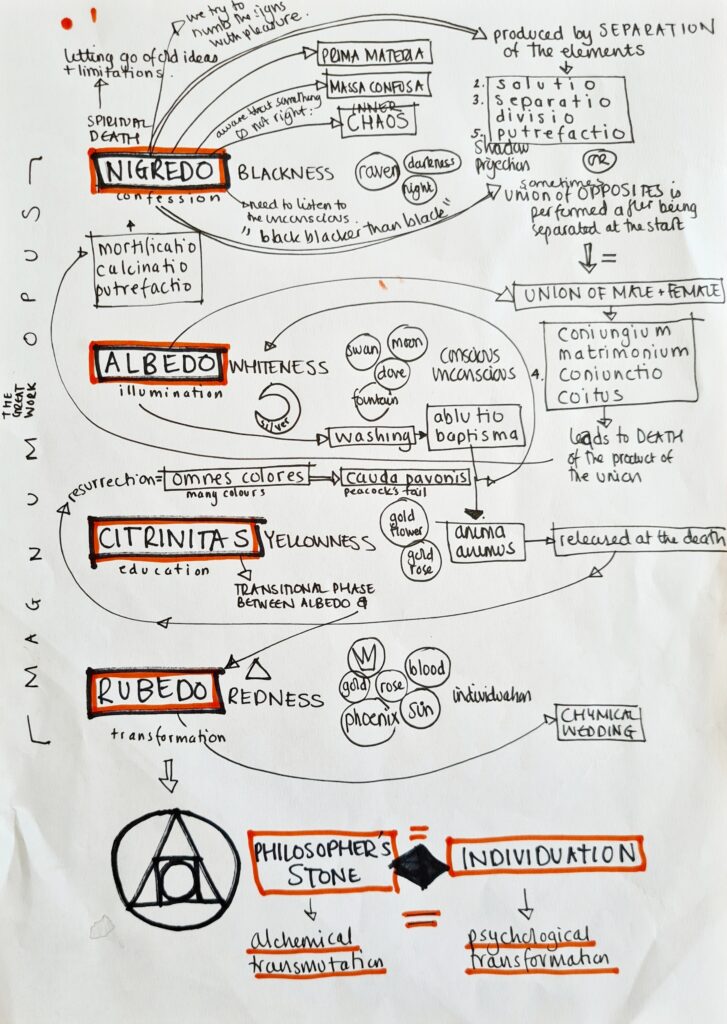
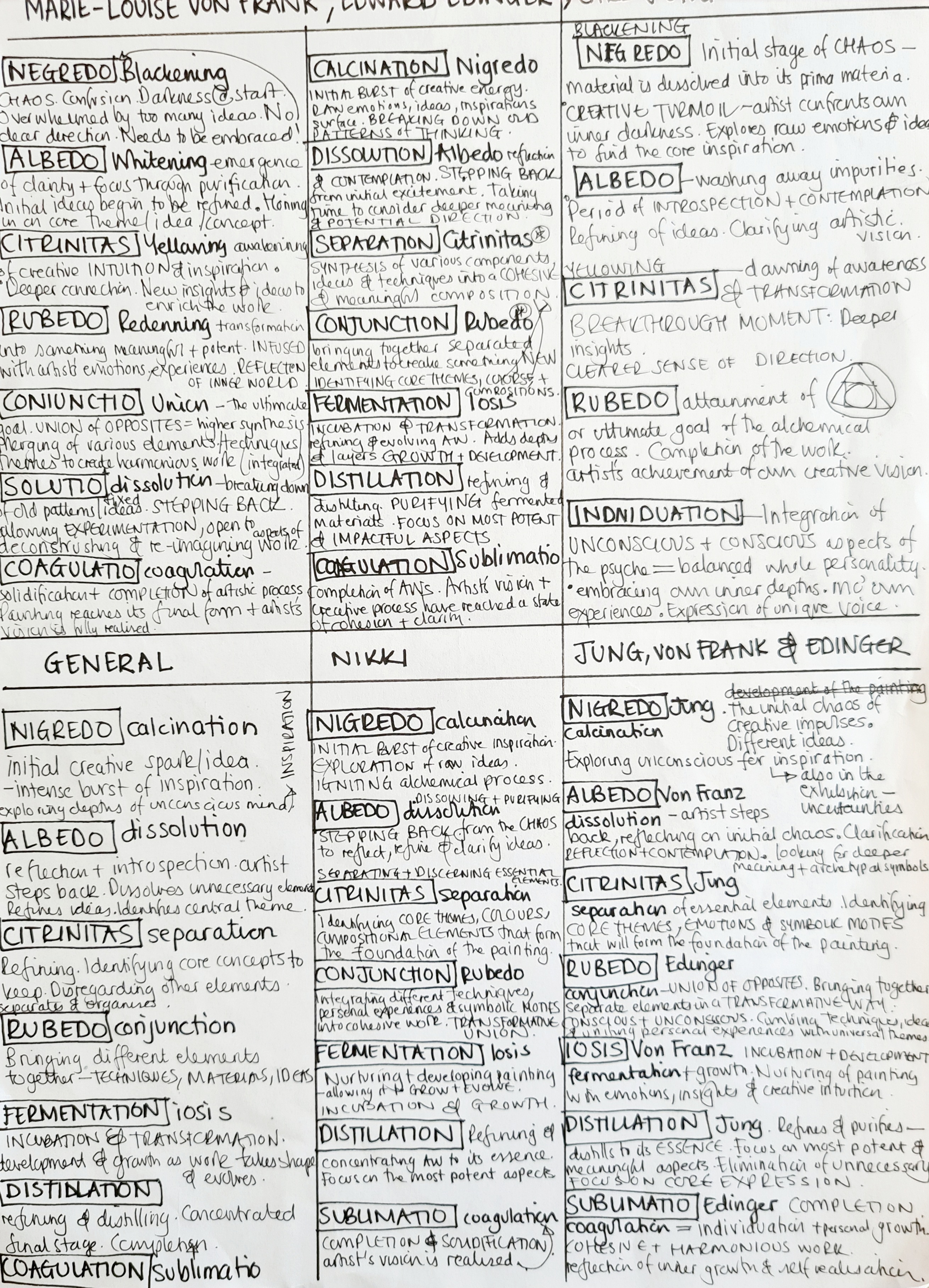
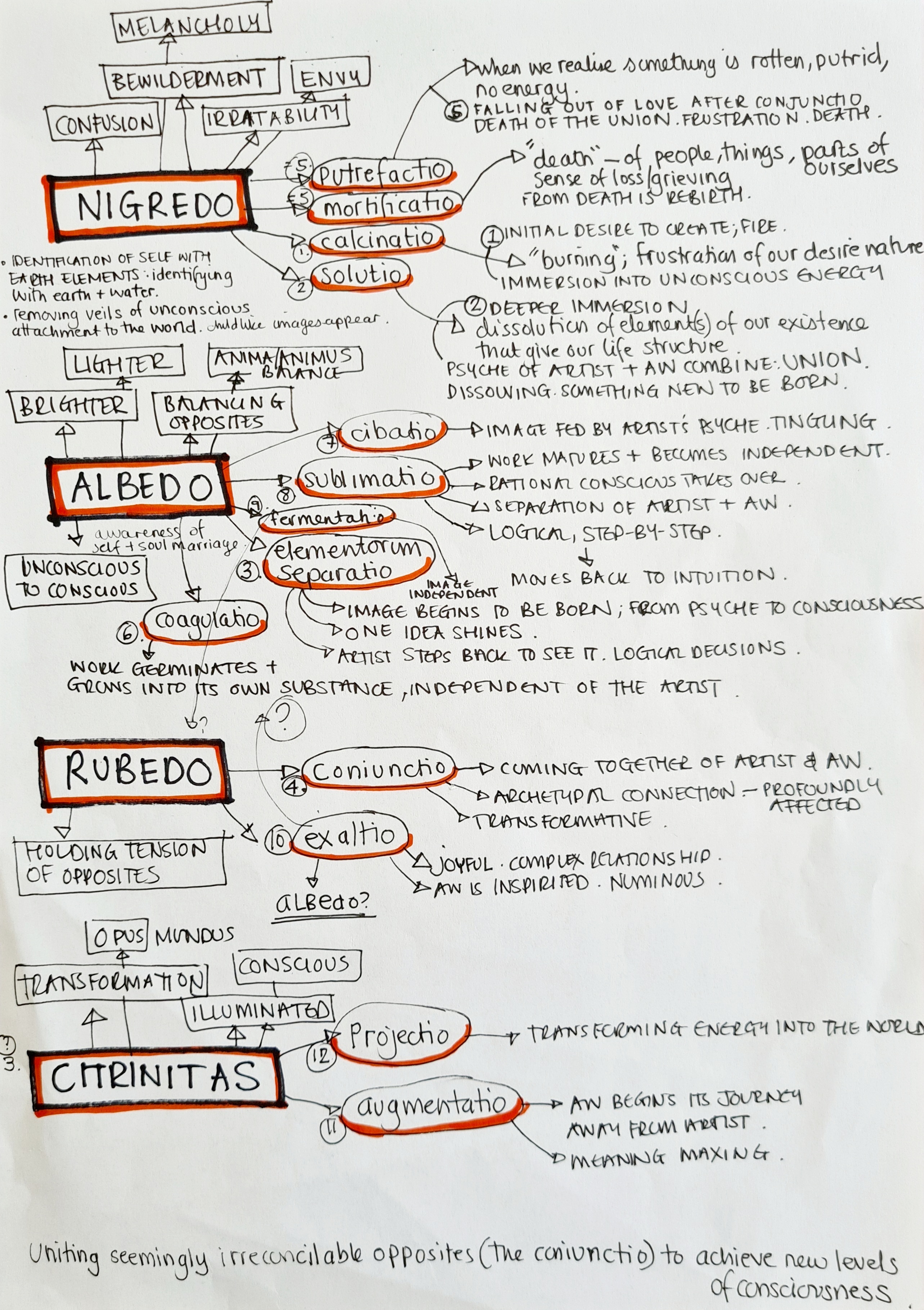
Examples of my reflexive process through selecting information from my journal notes.
To clarify, my research focus was to apply my new understanding of alchemical stages to an artwork that I created for my Inner Landscapes exhibition. After the initial shortlisted five works, I selected two which were chosen since they represented both the start and the end of my intensive artmaking journey for my exhibition. The first was created in the autumn of 2022, and was the result of initial ideas exploration via intuitive collage and sketchbook work, incorporating influences from my daily photographs in nature, and being processed through a combination of both intuitive and rational thinking.
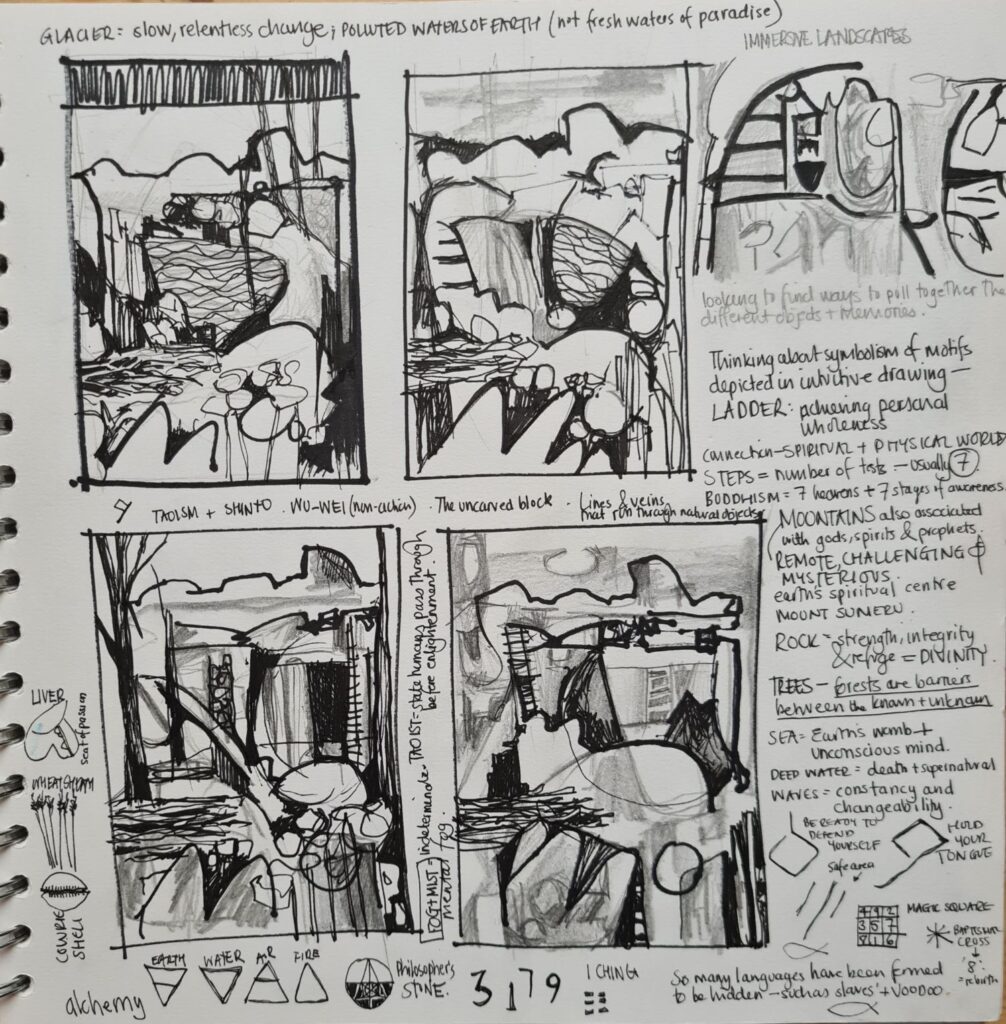
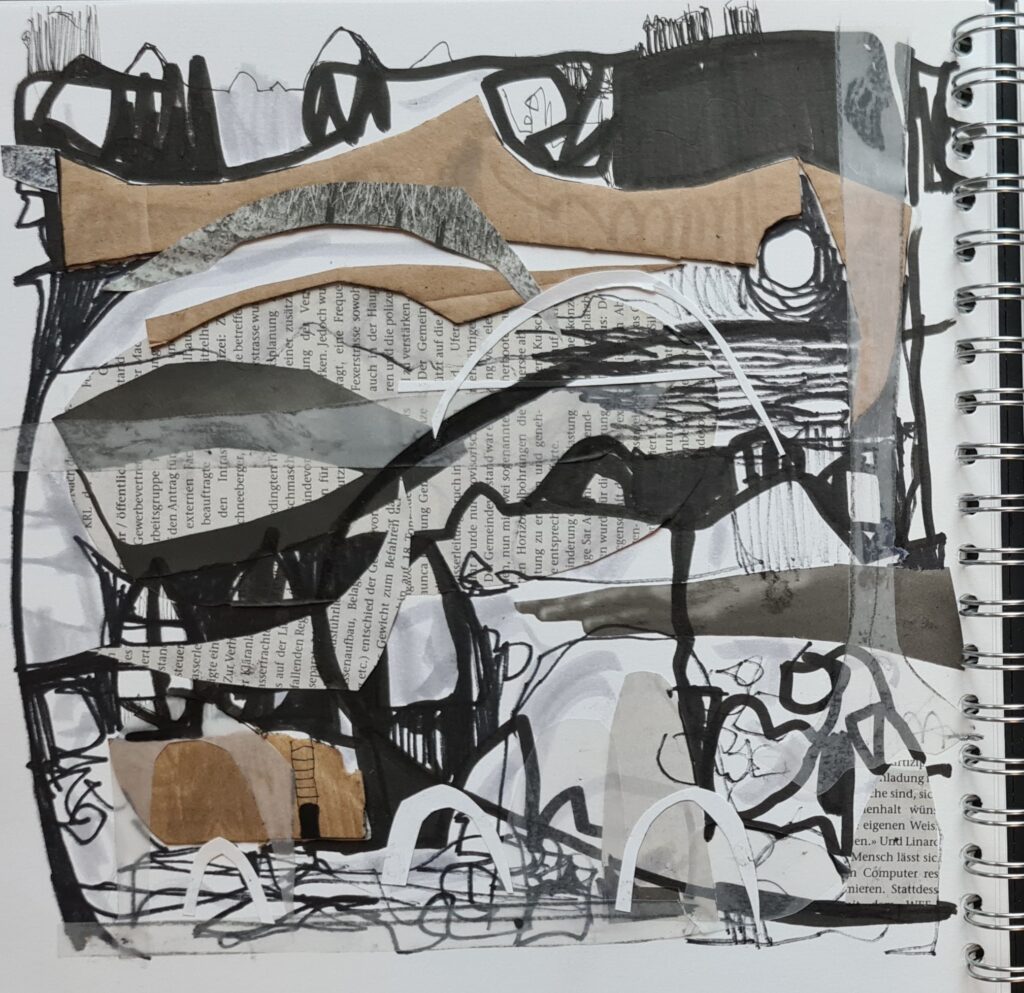
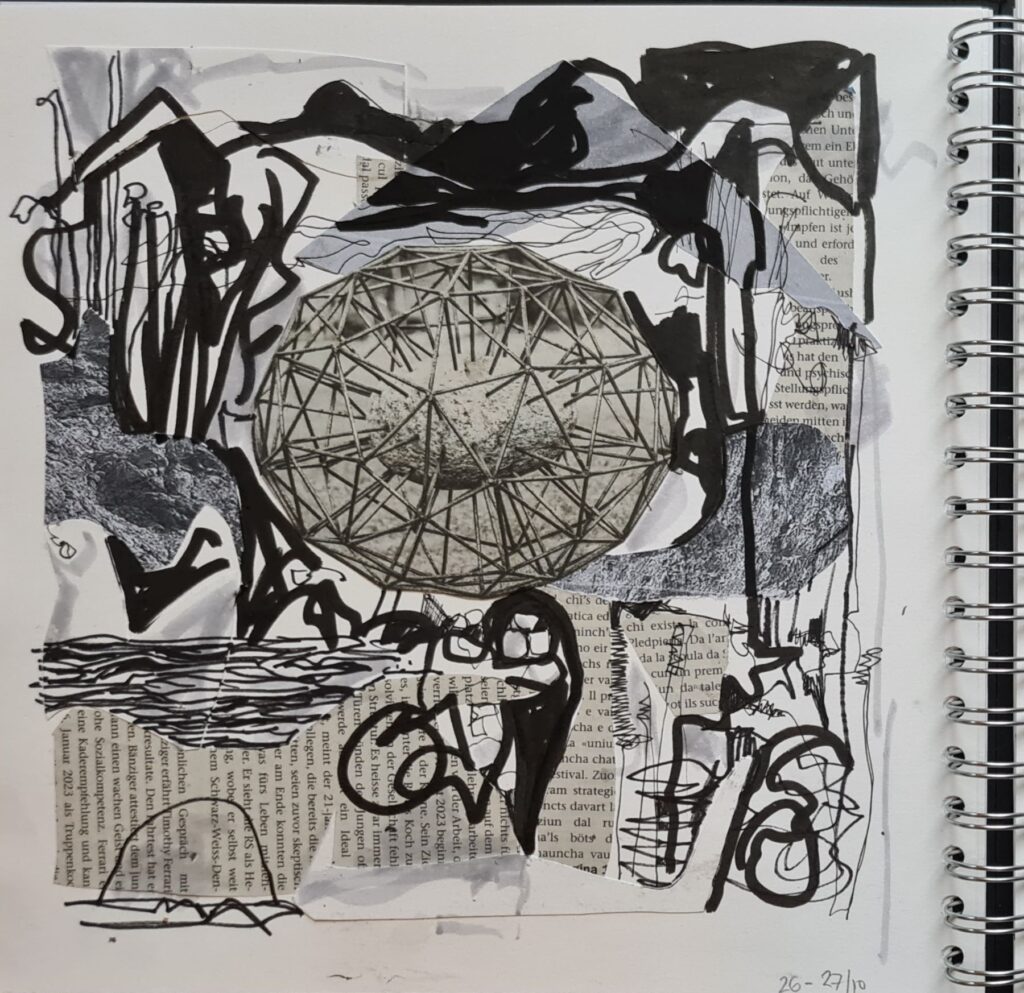

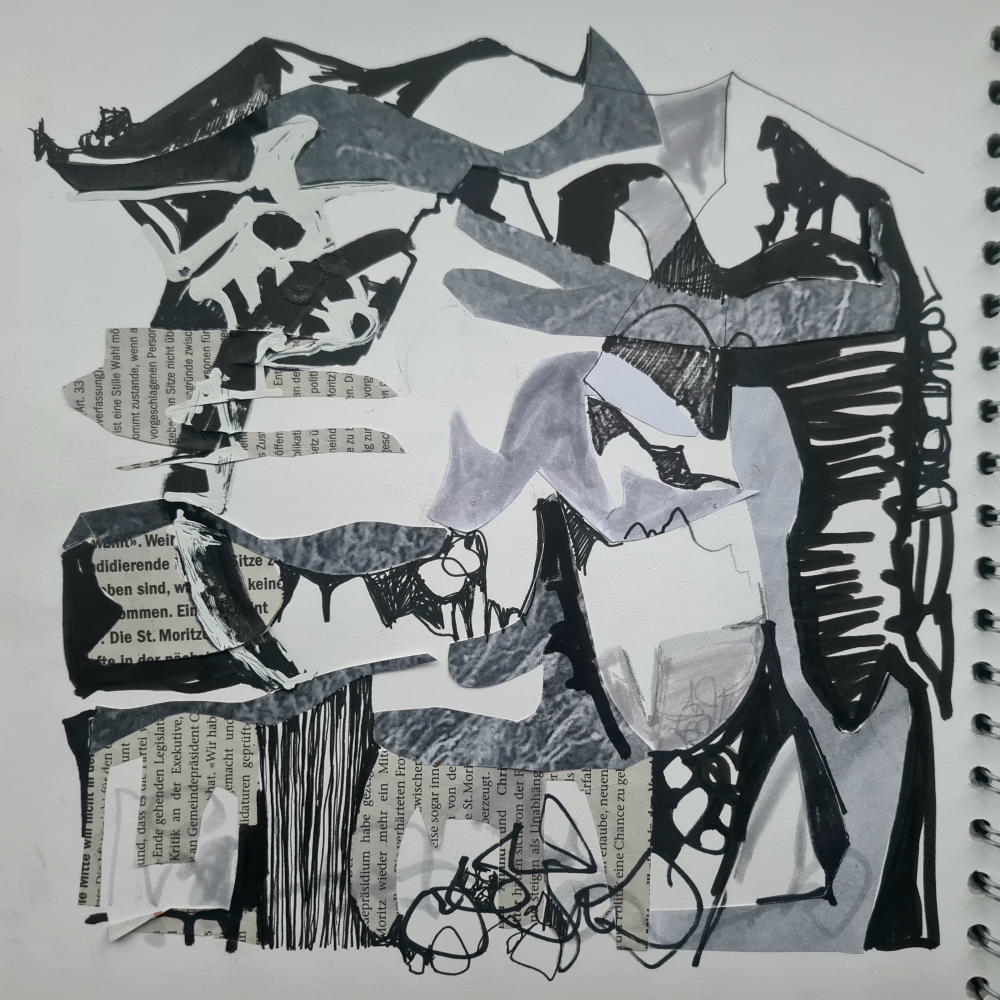
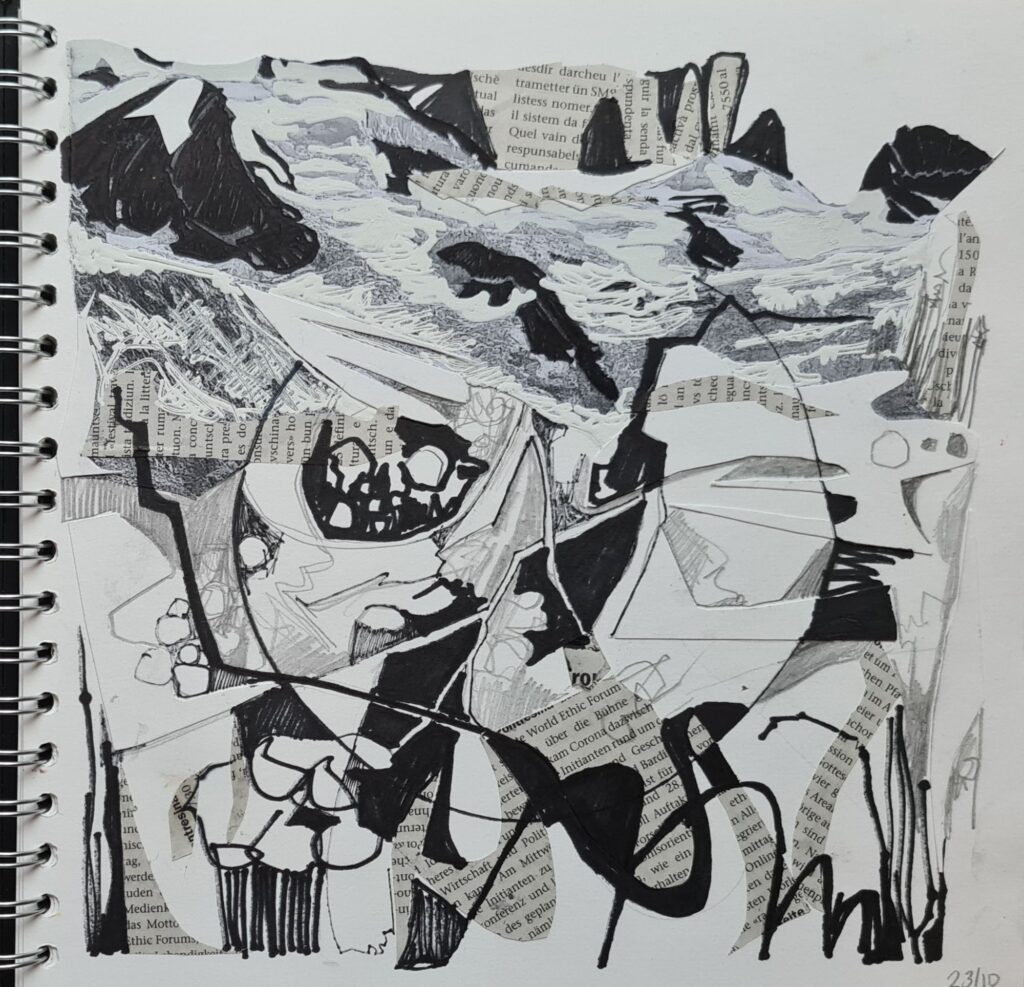

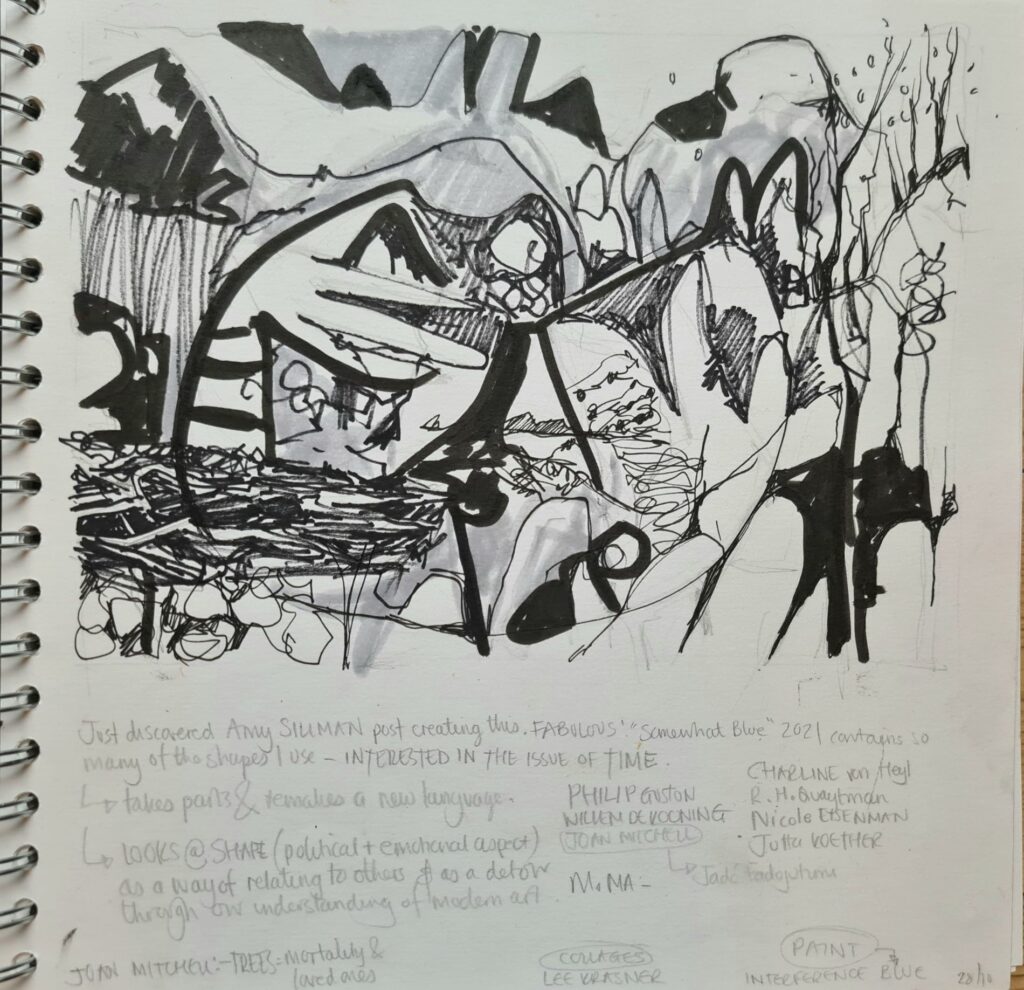
Starting off with initial sketches and ideas in response to my photographs of my surroundings, I turned to collage as a way of access a more intuitive way of creating. Rational thinking was used to select and arrange the composition, using collage and then ink. There was a constant interplay between intuition and logic.
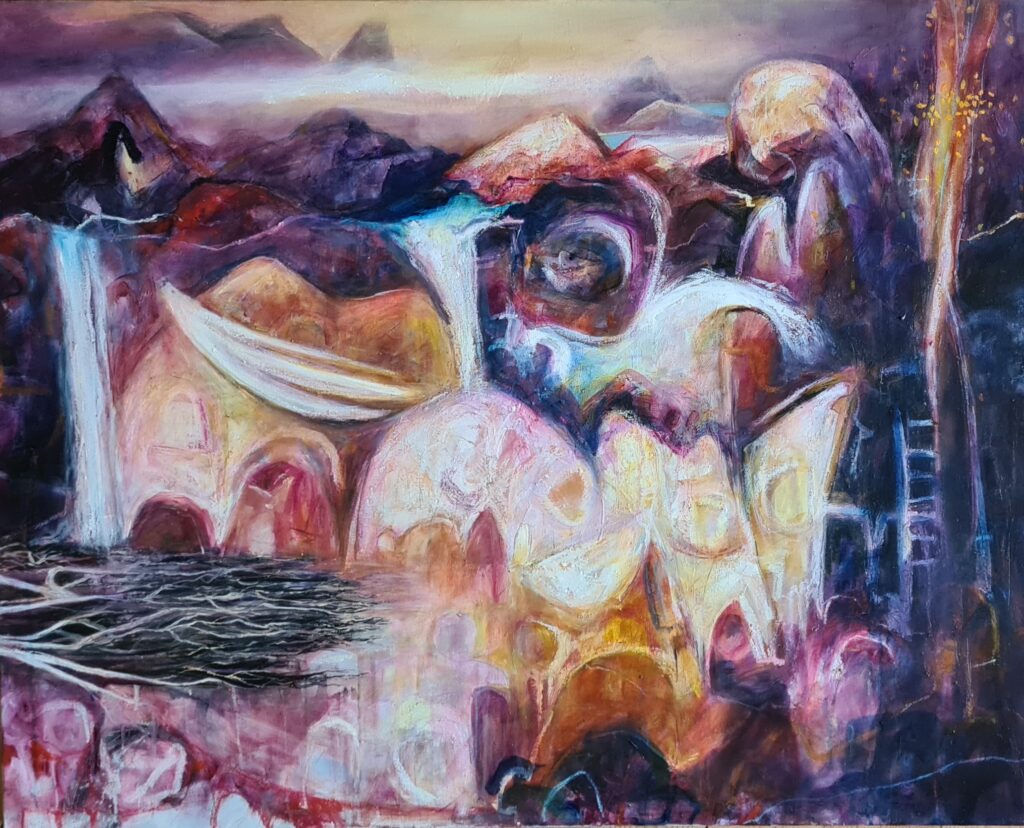
‘Somewhere there’s a place that I belong‘, 2022
oil, oil stick and oil crayon on canvas
100 x 120cm
The painting stages of ‘Somewhere there’s a place that I belong’, 2022
The second was created in the spring of 2023 and was one of the final works for the exhibition. It was created without any preconceived ideas or planning.
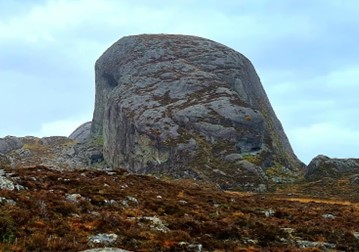
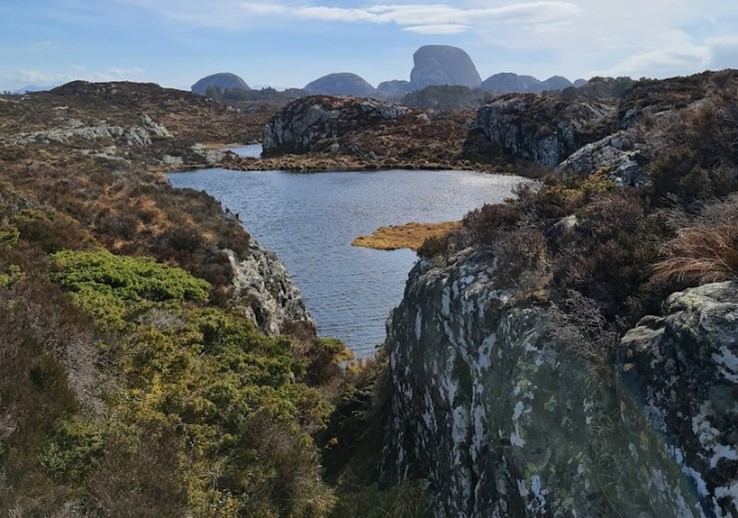
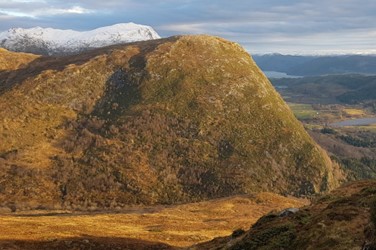
Common to my practice is using photographs from my personal collection, selecting those which speak to me at the time. As discovered through my Inner Landscapes exhibition and related research, the images should be chosen instinctively. I now understand this process as active imagination, with amplification through researching the possible symbolism enabling me to make sense of my choices.
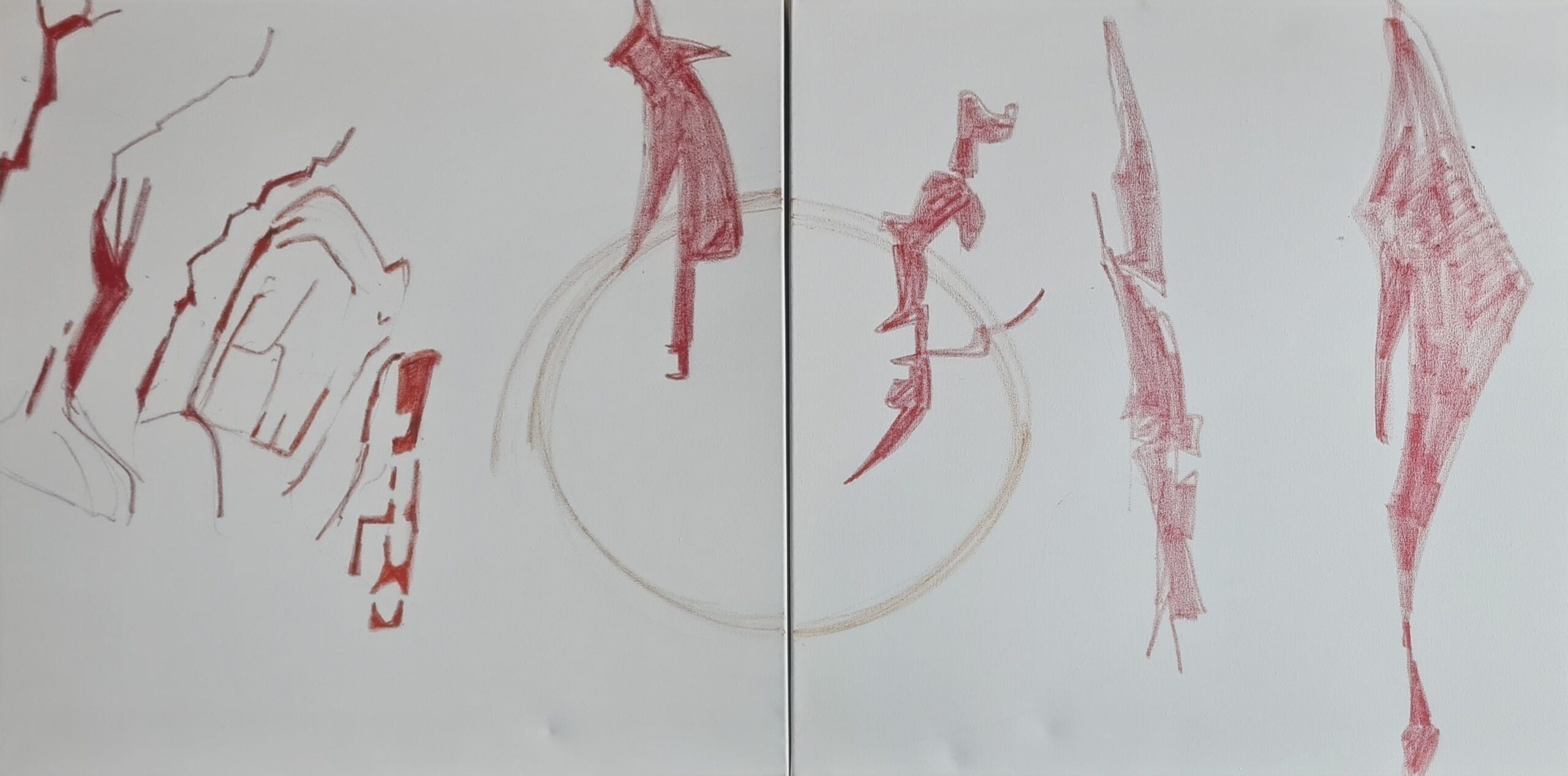
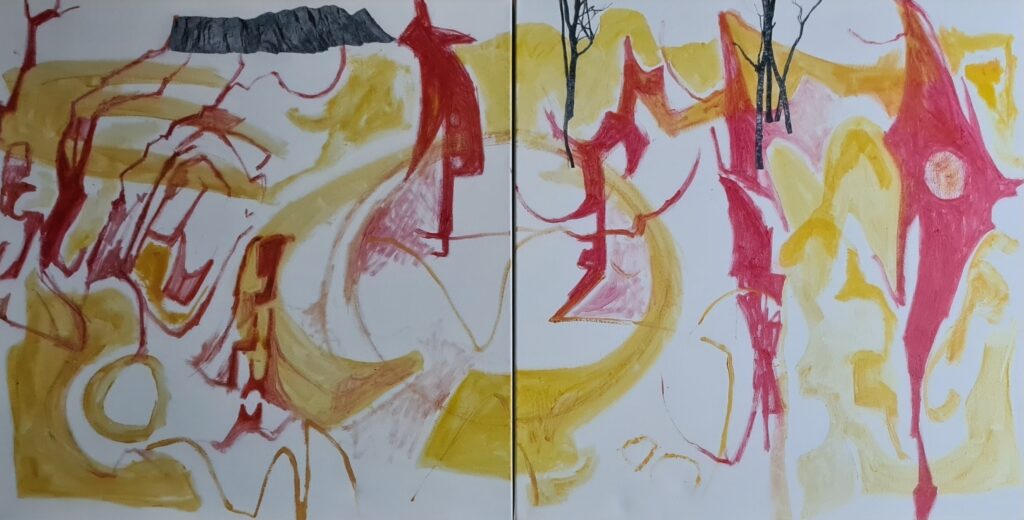
The initial drawing (above left) started as a response to a photograph of Lihesten, a local mountain here on the west coast of Norway. I was interested in the patterns and shapes in the rockface but had no idea of how the work would proceed. After accidently gluing a photograph of Lihesten at an incorrect angle, I tore it off, covered the space with dark blue oil and painted Høgkletten mountain instead (below right). At one point I drew all over the canvas with black ink, and then added another mountain to break up the composition, alternating between rational and intuitive approaches.
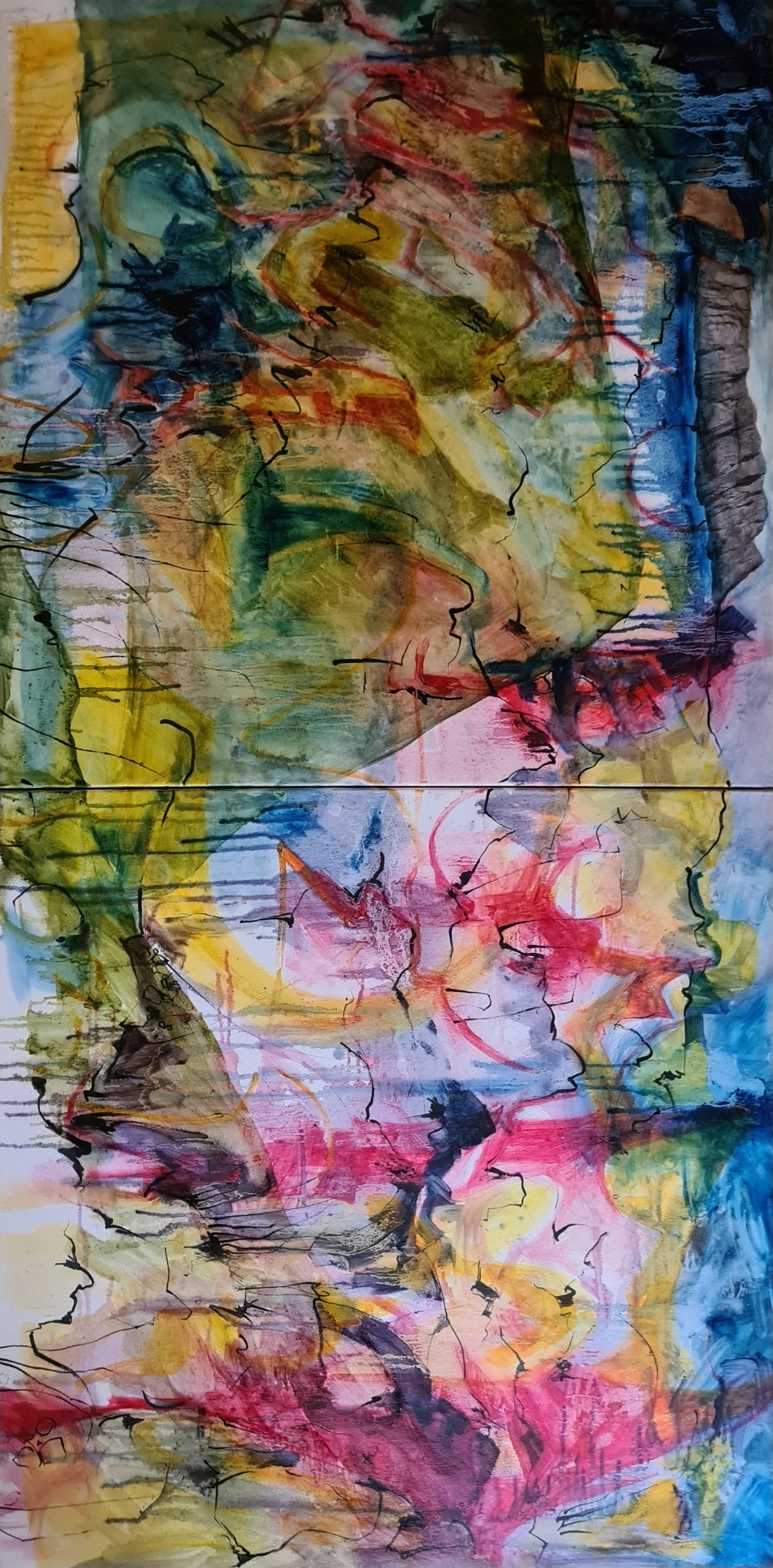
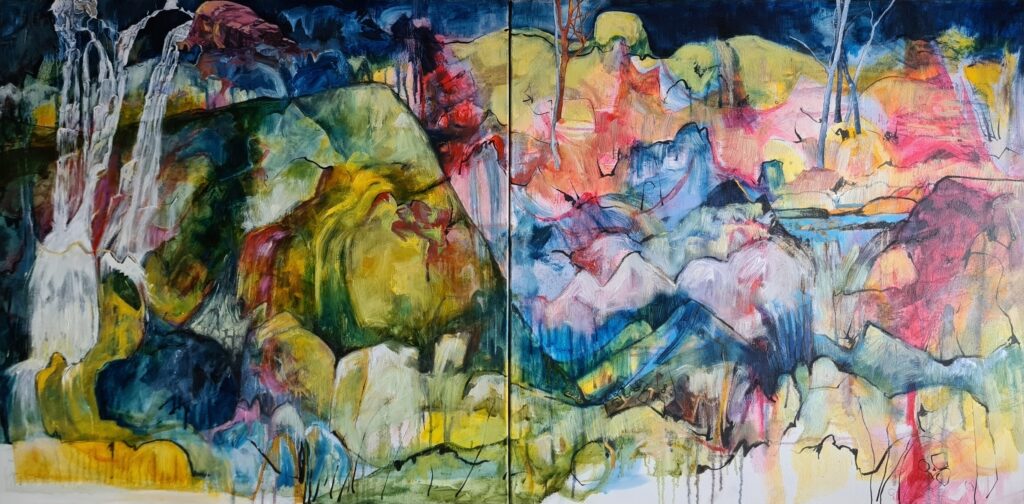
I had begun to understand these stages as representing: the initial confrontation of internal barriers in the alchemical stage of solutio, followed by separatio where gained clarity and began to refine my idea, coniunctio which was the stage of the merging of disparate elements, putrefactio when I erased parts of the work with ink and oil which brought new insights, and coagulatio which was the materialisation of the final work (below). Exhibiting the work represented the stage of projectio.
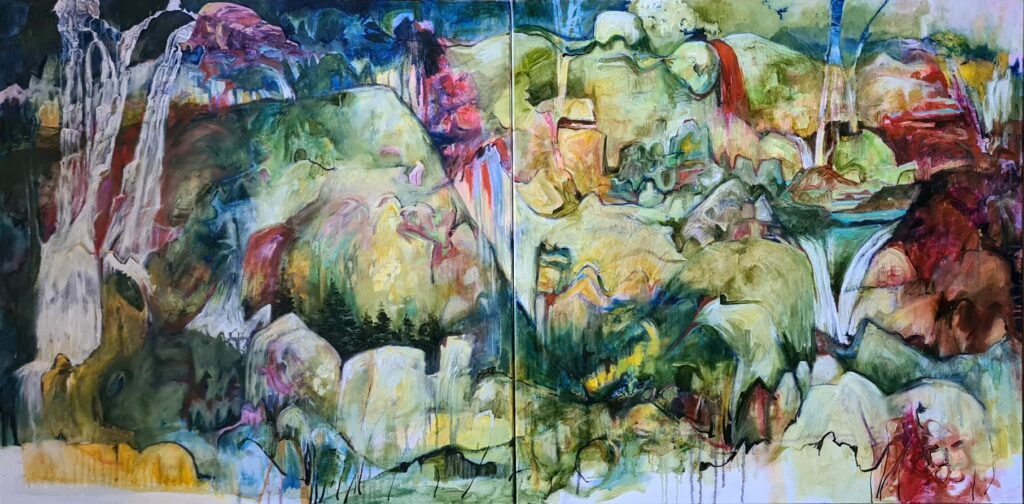
‘And into the nature I go, to lose my mind and find my soul‘, 2023
acrylic and oil on canvas
Diptych, 100 x 200cm.
DATA CODING
Initially, I created a chart which compared Jung, Edinger, and von Frank’s selected alchemical stages. There were many overlaps, and I saw that some stages were common to all. For example, Edinger understood that there were several steps that occur most frequently in alchemical texts. In his book Anatomy of the Psyche (1985), Edinger distinguishes between seven stages as the major ones that make up the alchemical transformation, using their Latin terms to differentiate the psychological processes from the chemical procedures. These are: calcinatio, solutio, coagulatio, sublimatio, mortificatio, separatio and coniunctio. Undecided, I wrote down the Latin titles of the eleven stages that I had selected through my theoretical research, calcinatio, solutio, separatio, putrefactio, fermentatio, sublimatio, coagulatio, coniunctio, augmentatio, projectio, and exaltatio. The titles were written on post-it notes with brief explanations of each stage underneath.
I selected and printed all the photographs that I had taken of each stage of each of the two paintings’ processes. On a large white canvas, I played with both the order of the creative work and the alchemical stages, photographing the ‘mood boards’ that I had created and reviewing the findings alongside my previous journal notes.
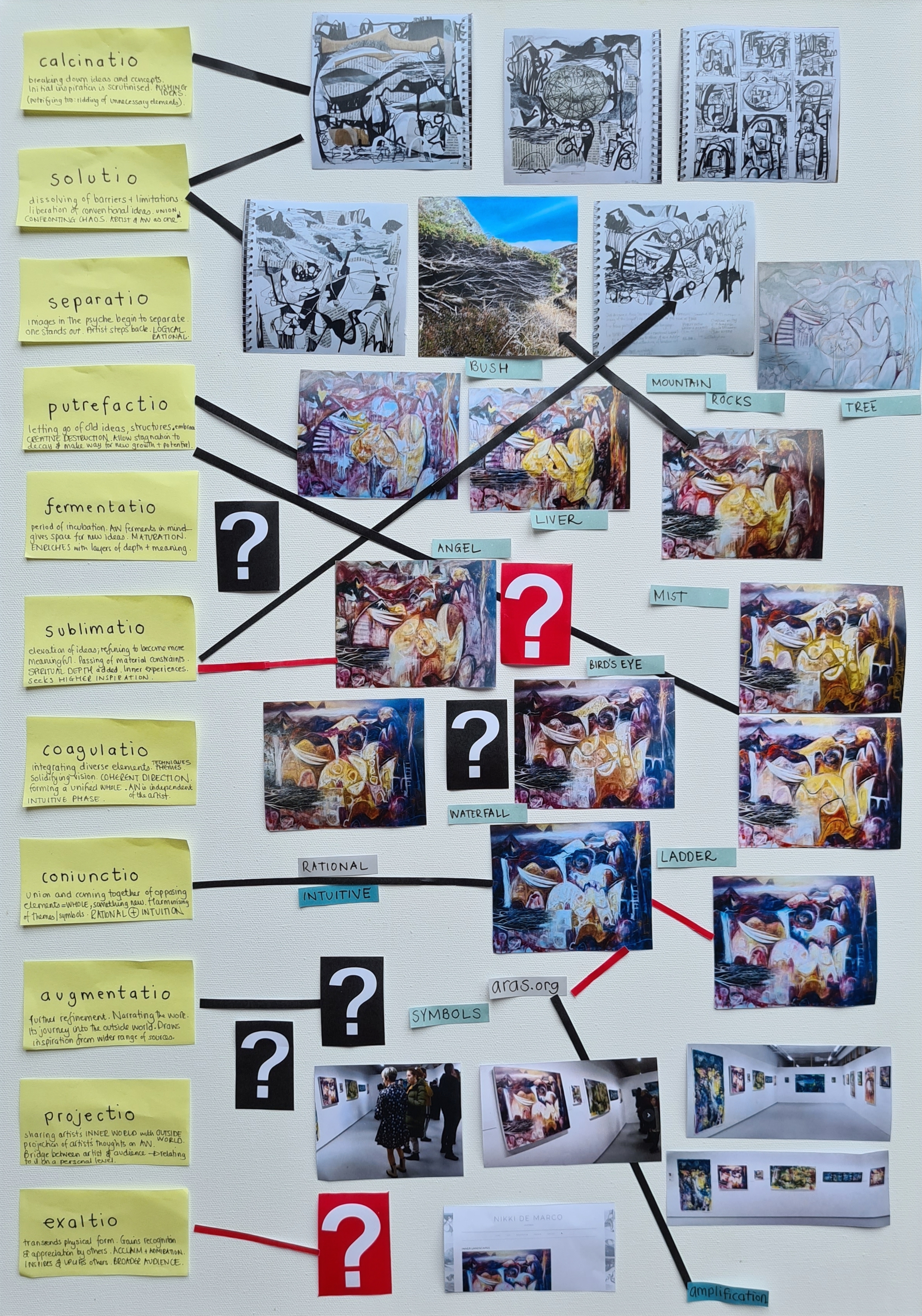
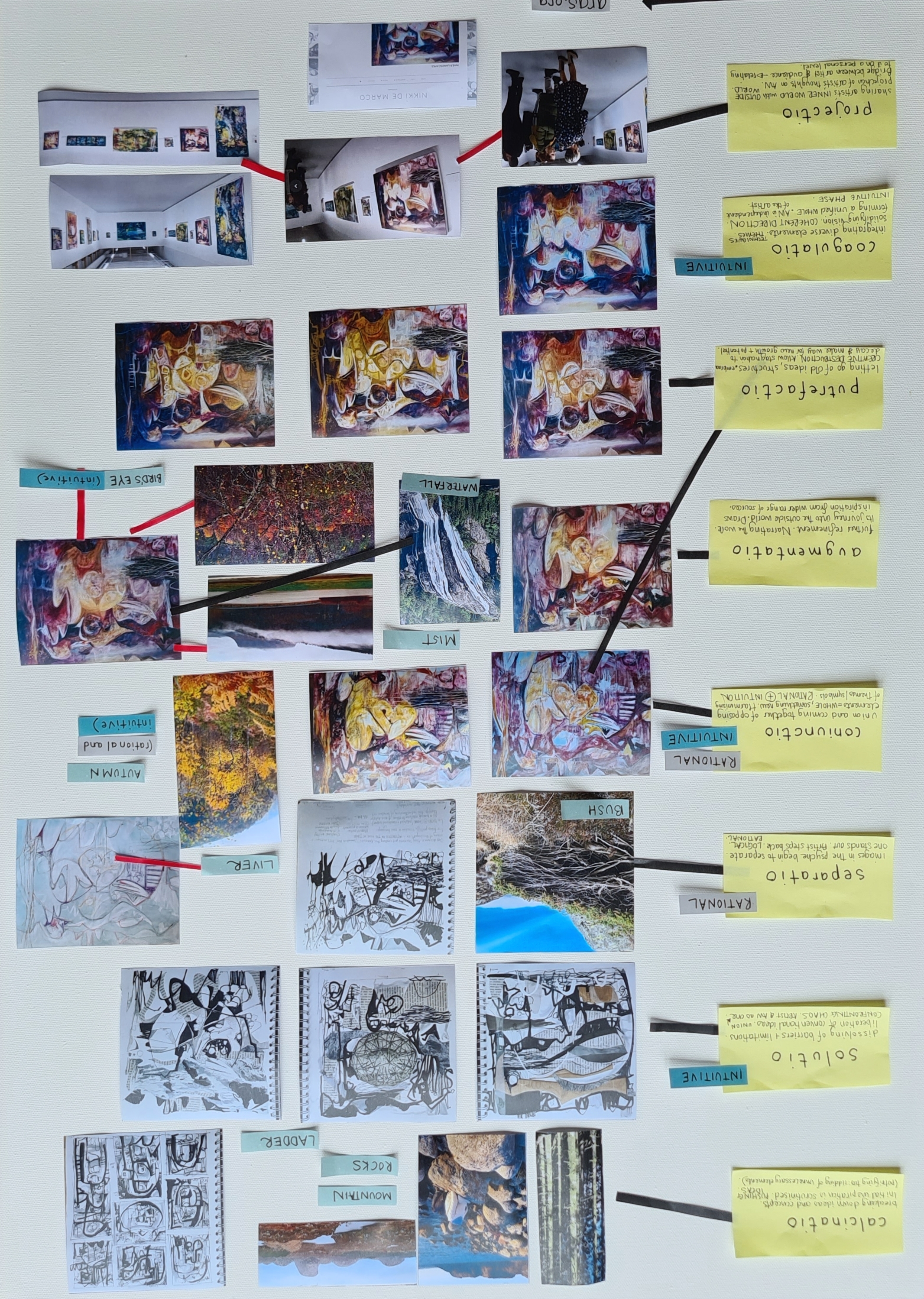
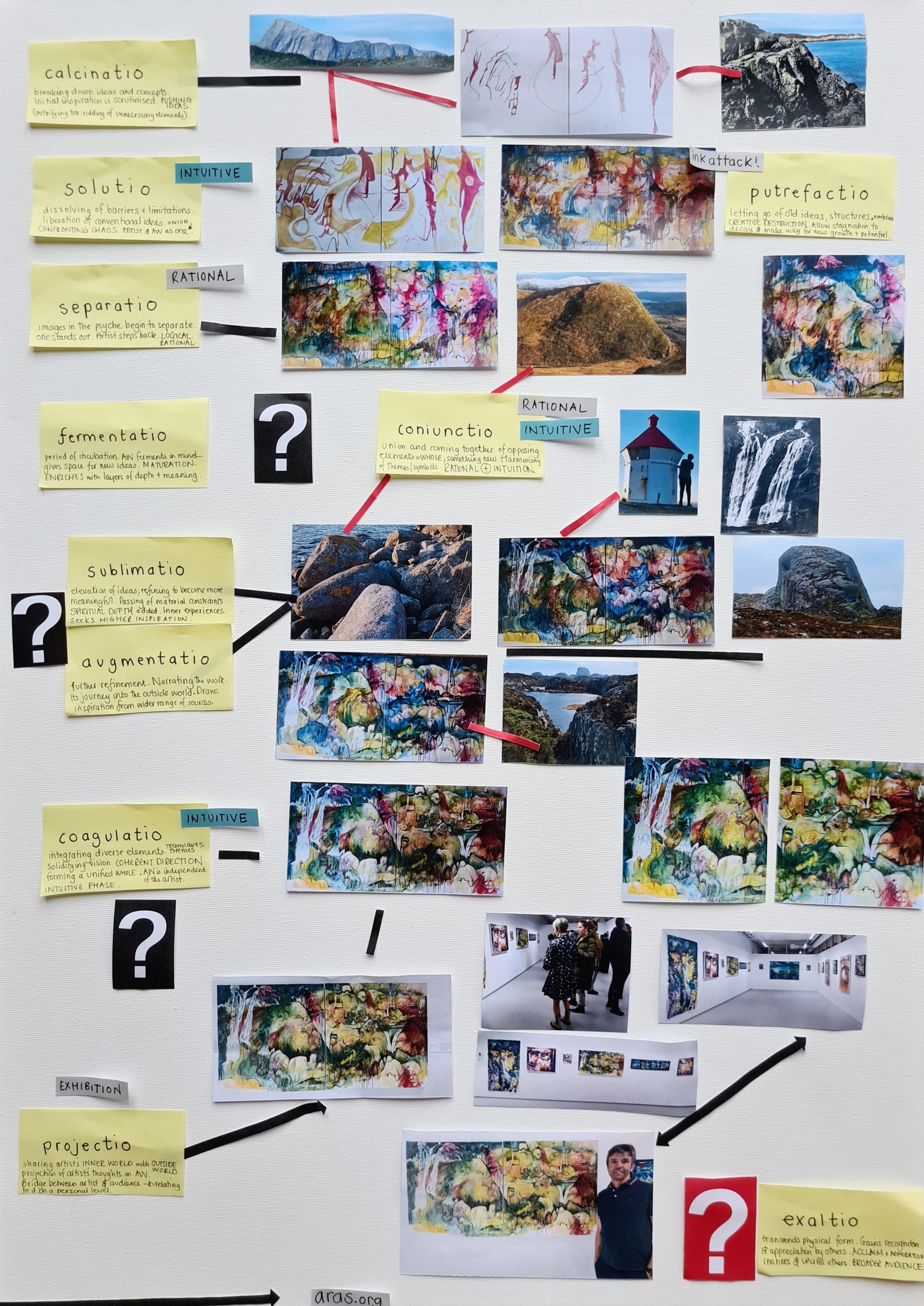
Examples of my data collection and coding process, as explained above.
I had intended to find a concrete structure which could be applied to the creative process, but what was both revealing and exciting was that I realised that the stages needed to be flexible, and whilst both works incorporated the majority of stages, there were obvious differences. For example, the stage of putrefactio which is part of the albedo phase and references creative destruction, which I find that I always do when I’m getting nowhere (here I pay gratitude to Diebenkorn whose notes to himself included using boredoms destructive potential), appears at different times of my creative process. Coniuntio, which is the union and coming together of opposing elements can happen early on, or much later. Separatio, where one image tends to stand out as the images in the psyche begin to separate, may not always happen, and if so, can occur at the very start and dictate the whole work, or much later. Of course, all of the above, as with the rest of my understandings are wholly personal to my interpretation and what makes sense to me. There are many interpretations of alchemical stages, and this flexibility enables one to apply a ‘best fit’. The stages are nonlinear, and one or more stages may repeat itself. I think that this is the joy in alchemy and why Jung connected with it on such a profound level; it is non-hierarchical and provides a framework and structure but only the individual can know how best to interpret and use it.
ALCHEMICAL STAGES APPLIED TO THE CREATIVE PROCESS:
For the alchemical interpretation of the creative process, I outlined 11 alchemical stages that I had developed a personal understanding of:
calcinatio: the initial inspiration, brainstorming ideas.
solutio: confronting the chaos of possible ideas, dissolving barriers, limitations & conventional ideas.
separatio: images within the psyche begin to separate and one idea and/or image stands out.
coniunctio: disparate and opposing elements are unified to create a new whole.
putrefactio: creative destruction destroys boredom and makes way for new possibilities.
fermentatio: time away gives space for reflection and new ideas, enriching work which follows.
sublimatio: refining of work to make it more meaningful, adding spiritual depth.
augmentatio: further refinement throughdrawing inspiration from a wider range of sources.
coagulatio: solidifying the vision and bringing cohesion through the completion of the work.
projectio: artist’s inner world is shared with the outer world and the artwork is a bridge between the audience and the artist who relate to it on their personal level.
exaltatio: artwork gains further acclaim and a broader audience, inspiring and uplifting others.
My module asked me to create an academic poster which summarised my research project, and although I initially saw these eleven alchemical stages fitting, making my poster revealed that this could be simplified to support my selected work, and thus further coding my data narrowed the stages down to seven as can be seen in the poster:
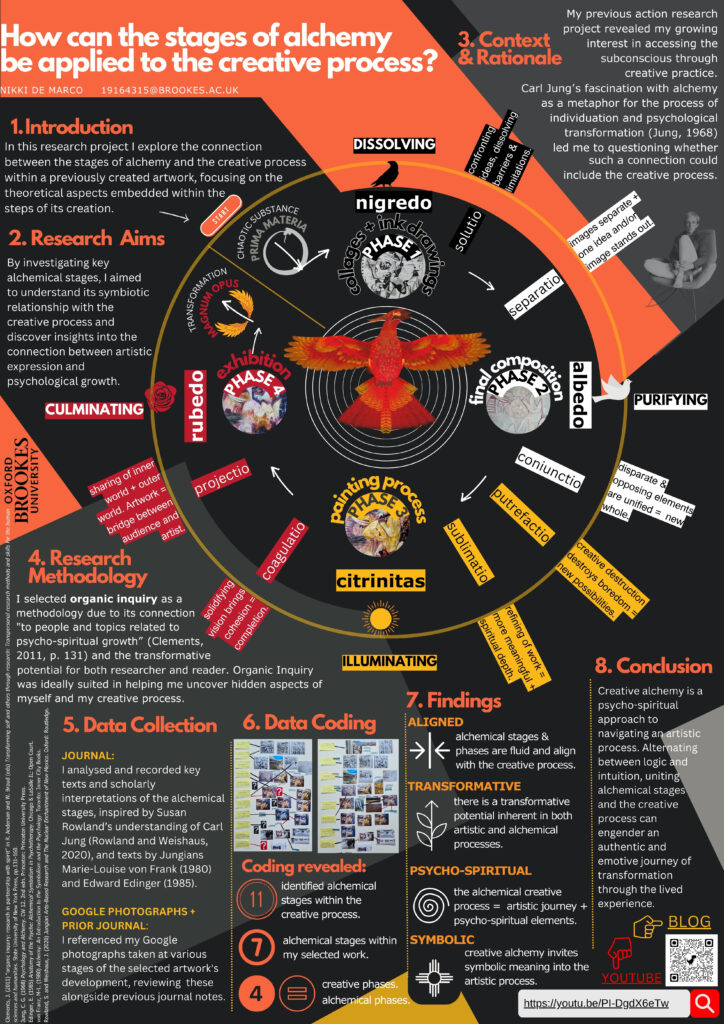
Image of my academic poster, summarising my research project.
THE FOUR ALCHEMICAL PHASES
As can be identified in the poster, the alchemical stages fit into the four alchemical phases of:

In my poster I coded each of the seven selected stages to show which of the four phases it best represents. Again, there is room for flexibility, for example, I saw how putrefactio could be a part of citrinitas or rubedo.
APPLYING THE 7 STAGES and 4 PHASES TO THE CREATIVE PROCESS
I had understood what part of the creative process fitted each of the selected alchemical stages, and I had applied this to the four alchemical phases. The last step was to align each of the alchemical stages with the four phases of the creative process as I understood them for my selected work:
PHASE 1: Intuitive Collages and Ink Drawings;
PHASE 2: Final Composition and Canvas Drawing;
PHASE 3: Painting Process;
PHASE 4: Exhibition.

CONCLUSION
Jung and his contemporaries were deeply inspired by the connection between alchemical stages and the individuation process as the journey of self-realisation and psychological growth. Supported by organic inquiry, my research project revealed how alchemical stages can be mirrored and interpreted within the context of the creative process, unveiling the transformative potential inherent in both artistic and alchemical processes.
Jungian alchemical stages and the creative process encourage a journey of confrontation, exploration, and challenges through the lived experience. The fascinating journey of creative alchemy alternating between logic and instinct led to my experience of authentic artistic and psychological development in support of my ongoing transformative journey of self-discovery. The difference between creative process and the alchemical creative process is clear; the latter is a metaphorical framework that draws parallels between the stages of alchemy and the transformative journey within the artistic process. It includes exploring the symbolic meanings, psychological aspects, and inner transformation experienced by the artist during the creation of the artwork. It is more than the physical artwork, enabling self-discovery, personal growth, and the transmutation of creative energy into deeper insights. The alchemical creative process combines the creative journey with philosophical and spiritual elements, focusing on a deeper understanding of the relationship between the artist’s psyche and the transformative potential of the artwork.
References
Clements, J. (2011) “organic inquiry: research in partnership with spirit” in R. Anderson and W. Braud (eds) Transforming self and others through research: Transpersonal research methods and skills for the human sciences and humanities. State University of New York Press, pp.131-160.
Jung, C. G. (1968) Psychology and Alchemy. CW 12. 2nd edn. Princeton: Princeton University Press.
Edinger, E. (1985) Anatomy of the Psyche: Alchemical Symbolism in Psychotherapy. Chicago & LaSalle IL: Open Court.
von Franz, M-L. (1980) Alchemy: An Introduction to the Symbolism and the Psychology. Toronto: Inner City Books.
Rowland, S. and Weishaus, J. (2020) Jungian Arts-Based Research and The Nuclear Enchantment of New Mexico. Routledge. https://eternalisedofficial.com/2022/07/30/alchemy-and-psychology/
To see my supporting video please see: https://youtu.be/PI-DgdX6eTw